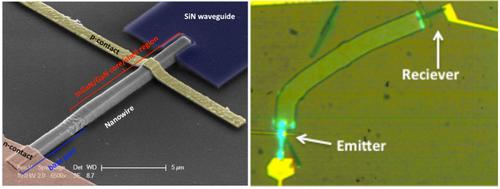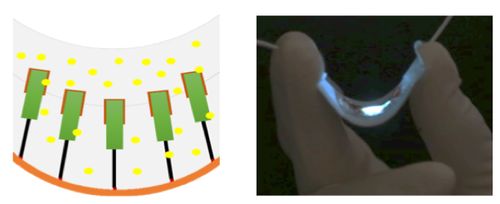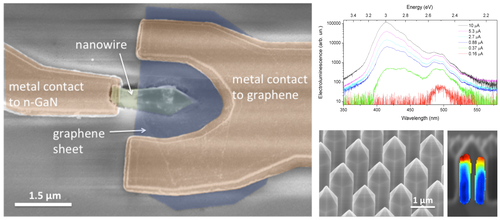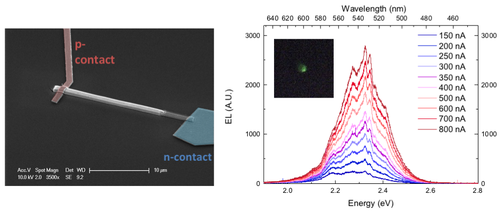-
Integrated photonic platform based on InGaN/GaN nanowire emitters and detectors
There is a growing demand for heterogeneous integration of photonic components with non-photonic elements (such as electronic circuits, micro-electromechanical systems, bio-sensors, etc…) to fabricate compact platforms with different functionalities. Nitride nanowire optical components present an ideal solution to implement this kind of integrated platforms in the visible spectral range.
We fabricated a photonic platform composed of single wire LED and photodetectors optically coupled by waveguides. MOVPE-grown InGaN/GaN p-n junction core-shell nanowires have been used for device fabrication. To achieve a good spectral matching between the emission wavelength and the detection range, different active regions containing either five narrow InGaN/GaN quantum wells or one wide InGaN segment were employed for the LED and detector, respectively. The communication wavelength is 400 nm. The devices are realized by means of electron beam lithography on Si/SiO2 templates and connected by around 100 µm long non-rectilinear SiN waveguides. The photodetector current trace shows signal variation correlated with the LED on/off switching with a fast transition time below 0.5 sec.

References:
•M. Tchernycheva, A. Messanvi, A. de Luna Bugallo, G. Jacopin, P. Lavenus, L. Rigutti, H. Zhang, Y. Halioua, F. H. Julien, J. Eymery, C. Durand, “Integrated photonic platform based on InGaN/GaN nanowire emitters and detectors”, Nano Letters 14, 3515 (2014)
•Nan Guan, Andrey Babichev, Martin Foldyna, Dmitry Denisov, François H Julien, Maria Tchernycheva “Optimization of the optical coupling in nanowire-based integrated photonic platforms by FDTD simulation”, Beilstein journal of nanotechnology Volume 9, Issue 1, Pages 2248-2254 (2018).












